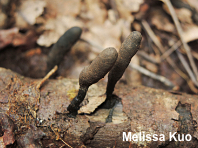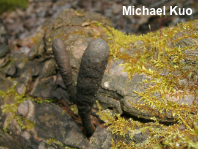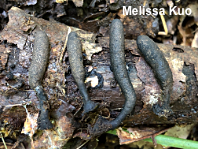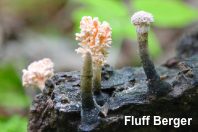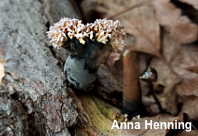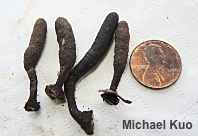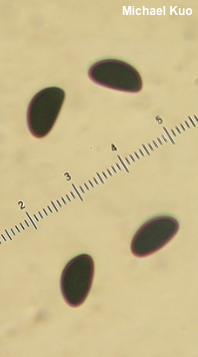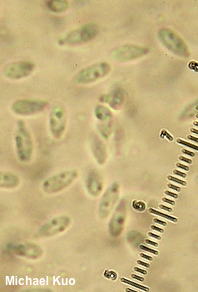| Major Groups > Clubs & Corals > Xylaria > Xylaria cubensis |

|
Xylaria cubensis [ Ascomycota > Sordariomycetes > Xylariales > Xylariaceae > Xylaria . . . ] by Michael Kuo This club-shaped species of Xylaria is fairly common in the southeastern states, the lower Appalachians, and in the tropics, but rare or absent elsewhere in North America. It grows directly from the wood of decaying hardwood logs, and features a coppery brown surface (before it eventually turns black). Under the microscope it has fairly small spores that usually lack the "germ slits" common to many other Xylaria species. The "anamorph," or asexual stage, of Xylaria cubensis looks quite a bit different from its sexual stage. Though the anamorph was recognized previously by some as a separate species, "Xylocoremium flabelliforme," current taxonomic rules require sexual and asexual stages to be treated as one taxonomic entity. The anamorph appears in winter, spring, and early summer, and looks a bit like soggy cotton candy on a tiny stick. Thanks to Fluff Berger and Anna Henning for collecting, documenting, and preserving Xylaria cubensis for study; their collections are deposited in The Herbarium of Michael Kuo. Thanks also to Sherwood Forest Friends for facilitating collection of specimens. Description: Ecology: Saprobic on decaying hardwood logs, growing directly from the wood; growing alone or gregariously; causing a soft rot; spring through fall (or over winter in warm climates); originally described, as the species name suggests, from Cuba—but common throughout tropical and subtropical areas, the southeastern United States, and the Appalachian Mountains; absent in western and northern North America. The illustrated and described collections are from North Carolina, Pennsylvania, and Massachusetts. Fruiting Body: 2–8 cm tall; 0.5–1.5 cm across; shaped more or less like a club, with a rounded tip; surface coppery brown, becoming blackish with maturity; becoming minutely pimpled with perithecia and shallowly wrinkled with maturity, but not developing deep fissures and cracks; pseudostem short or almost nonexistent. Anamorph (see discussion above): 0.5–2.5 cm high; up to 1 cm wide; at first narrowly club-shaped with a black to whitish surface; apex becoming expanded into a tightly to loosely lobed crown with a finely granular, white to pinkish or pale orange surface; base swollen where attached to the wood, covered with fine black fuzz. Microscopic Features: Spores 9–11 x 4–5.5 µm; ellipsoid, with a somewhat flattened side; usually lacking germ slits but occasionally with a narrow, inconspicuous slit running the length of the spore; smooth; very dark brown in KOH; walls 0.5–1 µm thick. Asci 8-spored. Conidia on anamorphs 3–4 x 1–2 µm; subcylindric with one fusiform end; smooth; hyaline in KOH. REFERENCES: (Montagne, 1840) Fries, 1851. (Saccardo, 1882; Rogers, 1984; Rogers, 1986; Rogers, Miller & Vasilyeva, 2008; Kuo & Methven, 2010; Beug et al., 2014; Woehrel & Light, 2017; Elliott & Stephenson, 2018.) Herb. Kuo 03100702, 06091802, 06221903, 08111903. This site contains no information about the edibility or toxicity of mushrooms. |
© MushroomExpert.Com |
|
Cite this page as: Kuo, M. (2019, August). Xylaria cubensis. Retrieved from the MushroomExpert.Com Web site: http://www.mushroomexpert.com/xylaria_cubensis.html |
